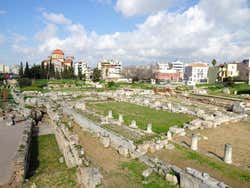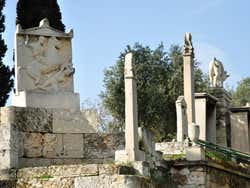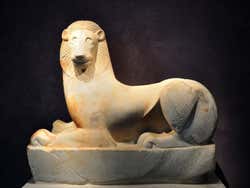
Kerameikos
Kerameikos is a neighborhood to the northeast of Athens also known as Ceramicus (meaning ceramic in English). The area took its name from the potters that lived in the area.
The area is also famous because it houses the largest cemetery in Greece, used by the Romans during the sixth century AD.
Several Centuries Earlier
Themistocles built a city wall around Athens in 478 BC to protect the Agora, dividing the neighborhood of Kerameikos in two. Since it was customary for the Athenians to bury the deceased outside the city, the outer part of Kerameikos became the city’s largest and most important cemetery.
Over the years, the cemetery was forgotten and remained buried for several centuries, until Pireos Street was built in 1862 to connect Pireos and Kerameikos. During the erection of the road, the first funerary monuments were found, which nobody knew the existence of.
Although the findings were given importance at first, they were quickly forgotten. Years later, a man who was on the site collecting earth, stumbled upon a large sculpted marble block. As a consequence, the Greek government bought the plot of land and began to dig up the cemetery.
Present Day
Nowadays, the archaeological site is open to the public. While wandering around it, visitors will enjoy the peaceful atmosphere that envelops the last resting place of the Ancient Greek citizens. The cemetery houses several tombstones and funerary monuments (although the latter are almost practically destroyed and require a lot of imagination to interpret them).
Kerameikos Archaeological Museum
Inaugurated in 1937, the Kerameikos Archaeological Museum is a small museum that displays the findings of the Kerameikos cemetery.
The various collections made up of statues, urns and other funerary monuments, are displayed chronologically in four different rooms.



Schedule
Winter: Every day from 8:00 a.m. to 3:00 p.m.
Summer: Every day from 8:00 a.m. to 7:00 p.m.
Closed: January 1, March 25, May 1, Easter Sunday, December 25 and 26.
Price
Adults: € 8 (US$ 8.78)
Students and seniors: € 4 (US$ 4.39)
Combined adult ticket: € 30 (US$ 32.95)
Combined student ticket: free
Includes: Acropolis, Ancient Agora, Roman Agora, Theater of Dionysus, Kerameikos, Temple of Olympian Zeus, Library of Hadrian and Aristotelian Lyceum
Free admission: March 6, April 18, May 18, last weekend of September and October 26
Nearby places
Ancient Agora of Athens (517 m) Monastiraki (706 m) Hadrian's Library (801 m) Roman Agora (869 m) Kanellopoulos Museum (918 m)

